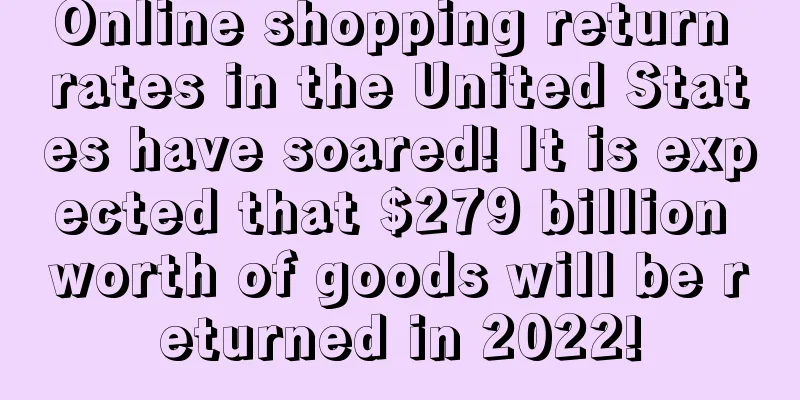Online shopping return rates in the United States have soared! It is expected that $279 billion worth of goods will be returned in 2022!

|
It is learned that according to the latest forecast from eMarket, US online shoppers will return $279.03 billion worth of goods this year, an increase of 8.4% from last year and more than double the amount in 2019 ($118.41 billion). Two key factors driving the growth in online returns are inflation and changes in consumer behavior. First, inflation has driven up commodity prices, leading to an increase in the value of returned goods. Second, shoppers are buying more clothes or other items than ever before, trying them on at home, and then returning unsatisfactory items. According to a recent study by Narvar, 63% of shoppers have engaged in this consumer behavior this year, an increase from 55% in 2019. According to a survey by Appriss Retail and Incisiv, in 2022, more than 90% (91%) of US retailers will see their return rates grow faster than revenue. The survey found that retailers’ online return losses accounted for 21% of the total order value due to increased packaging, labor and shipping costs. The survey also found that if another retailer makes the return process complicated or charges customers a return fee, shoppers will be reluctant to consume. Currently, 54% of US consumers will not shop at online retailers that charge return fees. Many retailers are taking steps to reduce online returns, including Walmart, which recently added curbside returns and door-to-door pickup and extended its holiday return period to January 31, 2023. To let shoppers learn more about products before buying, Walmart and IKEA have also launched AR features that let shoppers use their smartphones to see how furniture will look in their homes. Amazon also launched a virtual try-on feature for shoe buyers earlier this year. In addition, more and more retailers are working with third-party return service providers, such as PayPal's Happy Returns. eMarket predicts that in 2022, the value of online returns in the United States will account for 26.5% of consumer spending, far higher than 19.8% in 2019. The amount of returns from third-party marketplaces will reach US$43.5 billion. Editor ✎ Nicole/ Disclaimer: This article is copyrighted and may not be reproduced without permission. |
<<: Amazon, Wayfair and Ace Hardware break Cyber Week sales records
Recommend
Six tips to help you create beautiful Amazon product videos!
Product videos are a key part of e-commerce sales...
The training business that sells billions of products has obtained a national certificate, but its annual sales are 10 billion but the profit is less than 10 million?
▶ Video account attention cross-border navigation ...
What is Shopify Ping? Shopify Ping Review
Shopify Ping is a new APP launched by Shopify in 2...
What is Buy2Sell? Buy2Sell Review
Founded in 2015, it is a B2B e-commerce platform h...
5 stores were closed at the same time! All the "wool" that was taken away by illegal operations had already been secretly marked with a price
High quality chives My C position On January 29, t...
The latest common methods for deleting negative reviews on Amazon
When an Amazon buyer leaves a bad review for a ne...
Amazon's new feature is online! My brother-in-law actually copied Taobao
As the originator of e-commerce platforms, Amazon ...
What is LightInTheBox? LightInTheBox Review
LightInTheBox is a Chinese foreign trade B2C websi...
What is Xiaolaoban ERP? Xiaolaoban ERP Review
Small Boss ERP is a free professional foreign trad...
Dominating the North American e-commerce market! Will fashion still be the hottest track in 2022?
It is learned that the growth of e-commerce sales ...
BigCommerce acquires BundleB2B! Further strengthens To B business
It is learned that on April 26, BigCommerce announ...
Amazon has two new shipping features that you must know about!
Normal, once there is data abnormality, such as s...
12 Amazon summaries from well-known Amazon practical operation experts (pitfalls)
First, you cannot trust any service provider that...
Critical hit! Amazon announced an increase in FBA delivery fees, effective January 18!
▶ Video account attention cross-border navigation ...









